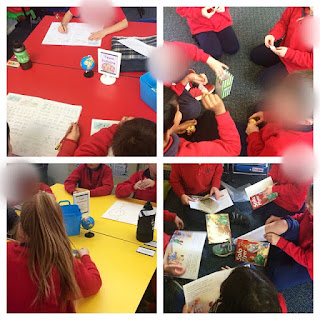I'm always excited to share things that are happening in my classroom. That's one reason I love Instagram. I recently shared the PowerPoint slide that I use for showing students their Reading and Maths groups, so I thought I'd share a bit more about how I've set them up.
Right at the beginning of this year I wrote a blog post over on the Australian Teachers Collaborative Blog about how I planned to run my Reading Groups. I was inspired by lots of blogs, and other teachers, and I had ideas that I was excited about. Unfortunately, it just didn't work out the way I'd planned. And that's ok! So much about teaching is trying new things, reflecting on them, and making changes. That is exactly what I did.
I started the year trying to give my students more choice, found that it didn't suit my students in the way I had envisioned it, so I dropped Reading Groups altogether. During term 2 I did whole group reading activities, not a lot of differentiating, and mainly comprehension work based on texts about our Inquiry topic. This didn't work either, and I found that my student achievement data didn't change the way it could/should. So...
I went 'back to basics'. In Australia, about 10 years ago, there was a
huge push towards the 'Early Years Literacy Block'. It was highly
structured, based on a group system for reading, and writing would
always follow straight after, for a total literacy block of 120min. I
had run my literacy block this way in the past, but didn't do it this year. During the winter holidays I re-read the training material for this framework, and decided I'd try it again. And so far, I love it!!!
A week in reading for me now includes:
- 15-20min every day of Independent Reading. Students self-select books from a huge range that I've collected over the years and store in The Book Corner. They have to have 4 'levelled texts', and 3 of something else (magazines, non-fiction books, early readers, picture books, chapter books, etc) which they store in the rainbow drawers next to the bookshelf.
- 2 lessons a week of comprehension-based, whole group tasks, focused on big ideas like inferring, visualisation and understanding character/setting.
- 1 lesson that starts with Independent Reading but is then taken up with spelling pre- and post-testing and setting weekly homework.
- 2 Reading Groups lessons.
 |
| The Book Corner |
 |
| Handwriting, Pop for Blends, Oral Language Storycards, Reciprocal reading |
For Maths Groups I have an almost identical set-up.
I have four maths groups, based on ability, and these are groups that were organised based on an addition pre-test. The four activities they do are: iPods (maths app), a maths game, task cards and teacher group. The only difference between the Reading Groups and Maths Groups is that I have a 'built in' teacher group in maths, whereas I don't have one in Reading. This is because my maths groups are based on the skill they're up to which is the focus for the teacher groups, whereas in reading they are grouped by reading level not skill.
 |
| Preparing some of the Maths Groups activities |
My school requires teachers to teach 2 days of Number/Place Value content every week (this is my Maths Group time), and 2-3 days of a maths topic from another area of the curriculum. For example, last week we learned about symmetry on the other days, next week we're learning about transformations.
The set-up for my resources and materials is simple, too. I bought tubs from Kmart (the coloured ones are from the kitchen section, and the grey ones are from the storage section). Maths tasks are in blue tubs, and reading are in red(ish) tubs. I haven't made the labels for the maths tubs yet, but the reading tubs have a label bulldog-clipped to them that matches the name of the activity on the planning table above. My students know where to find the tubs, where and how to put them back, and to keep our materials neat and tidy.
The set-up for my resources and materials is simple, too. I bought tubs from Kmart (the coloured ones are from the kitchen section, and the grey ones are from the storage section). Maths tasks are in blue tubs, and reading are in red(ish) tubs. I haven't made the labels for the maths tubs yet, but the reading tubs have a label bulldog-clipped to them that matches the name of the activity on the planning table above. My students know where to find the tubs, where and how to put them back, and to keep our materials neat and tidy.
I like the regularity and familiarity my students now have with these group set-ups. I like that it is easy to plan for. I like that they are practising core skills quickly and regularly, which is supporting their skills in other areas. For my class this really works!
I'd love to know how you run groups in your room. It constantly amazes me how many incredible ideas teachers come up with for running groups. We are a creative bunch!!








No comments:
Post a Comment